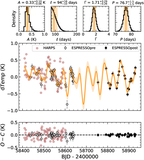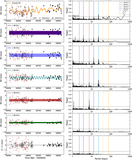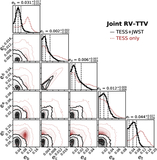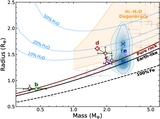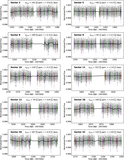Image Details
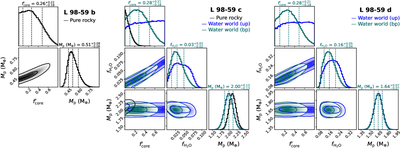
Caption: Figure 8.
Marginalized 1D and 2D posterior distributions of internal structure parameters for L 98-59 b (left), c (center), and d (right) derived with smint (C. Piaulet et al. 2023). The 2D posteriors display the 1σ and 2σ contours. The analysis constrains the core- and water-mass fractions (﹩f{{\prime} }_{{\rm{core}}}﹩, ﹩{f}_{{{\rm{H}}}_{2}{\rm{O}}}﹩) using priors on planetary mass (Mp) and irradiation temperature (Tirr; not shown), while requiring consistency with the observed planetary radius (Rp). The sub-Earth L 98-59 b is assumed to be purely rocky (﹩{f}_{{{\rm{H}}}_{2}{\rm{O}}}=0﹩). We explored a pure rocky model for L 98-59 c and water-rich models for L 98-59 c and d with either a uniform prior on ﹩f{{\prime} }_{{\rm{core}}}﹩ (“up”) or using ﹩f{{\prime} }_{{\rm{core}}}﹩ from planet b as a prior (“bp”). L 98-59 b has an ﹩f{{\prime} }_{{\rm{core}}}﹩ consistent with a wide range of iron content in the interior (from coreless to super-Mercury), with a mode close to Earth’s value (﹩f{{\prime} }_{{\rm{core}}}=0.325﹩; H. S. Wang et al. 2018). L 98-59 c likely has a small ﹩{f}_{{{\rm{H}}}_{2}{\rm{O}}}\sim 0.03﹩ to explain its mass and radius. For L 98-59 d, we infer a statistically significant ﹩{f}_{{{\rm{H}}}_{2}{\rm{O}}}﹩ = 0.16–0.18 irrespective of the choice of prior.
Copyright and Terms & Conditions
© 2025. The Author(s). Published by the American Astronomical Society.




